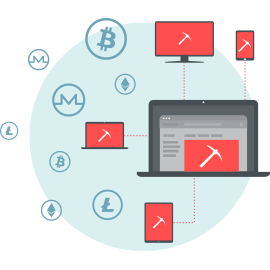What are malicious cryptominers?
Formerly, most malicious cryptomining code tried to download and run an executable on the targeted device(s). However, a different form of cryptomining malware has recently become very popular – in-browser mining that uses simple JavaScript. This method - also dubbed cryptojacking - enables the same malicious activity to be executed directly in a victim’s browser, without installing any software.
Read more

How to recognize a cryptomining attack?
Cryptomining and cryptojacking are associated with extremely high processor activity that has noticeable side-effects. Victims often report visibly reduced performance of their device, its overheating as well as increased fan activity (and thus noticeable noise).
On Android devices, the computational load can even lead to “bloating” of the battery and thus to physical damage to, or destruction of, the device.
Similar problems may be caused by a variety of issues in hardware or software; however in the case of cryptojacking, they become apparent after the victim accesses a specific website - probably one that incorporates the cryptomining JavaScript code.

Brief history
Malicious cryptominers became prevalent in 2017, mostly due to the increase in value of various cryptocurrencies. Older variants of such malicious code were typically intended to infiltrate the victim’s device and install the mining software. In September 2017, a new cryptocurrency mining service was made available, named Coinhive. Unlike with other cryptomining services, Coinhive’s customers only needed to place a few lines of JavaScript into their web pages so as to enlist their visitors’ CPU power to mine cryptocurrency directly in-browser.
Read more
ESET offers you an award-winning security
ESET HOME Security Premium
owerful, multilayered protection to encrypt sensitive data, manage passwords easily, secure online transactions and more. A user-friendly solution for enhanced privacy online. Secures Windows, macOS, Android, and iOS devices.




